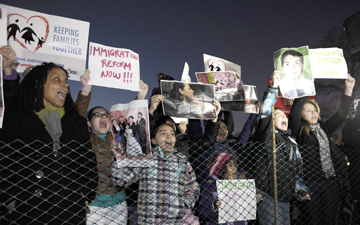Sania Ahmad
Contributing Writer

In the past few weeks, the topic of immigration has been brought up on university campuses. Between the controversy behind the University of Texas’s “Catch an Illegal Immigrant” game and the University of California at Berkeley’s student body resolution that deemed the phrase “illegal immigrant” as racist and dehumanizing, immigration continues to be a hot topic. Oftentimes, arguments on immigration focus on economic or social policy. Yet there is another factor that is rarely brought up, the idea of national identity.
National identity is the shared sense of belonging and sentiment toward a nation. It is a vital part of fostering community. Yet, it can also be used as a means to exclude individuals. This is particularly true for individuals immigrating into a new country.
To understand the significance of national identity, let’s take the example of the United Arab Emirates, a country in which 80 percent of the population is considered immigrants or expatriates. The U.A.E strives to create a “nationally uniform culture,” a culture that is rooted in Arab, Sunni Muslim tradition. However, about 70 percent of these immigrants come from Asia, believe in a diverse array of religions, and have a limited amount of education. The overwhelming number of expatriates in the country has created a psychological identity threat for Emiratis. The Emirati government has responded to this threat through the use of repressive policy such as a lack of collective bargaining rights and strict language laws toward expatriates. Additionally, the U.A.E. has a policy which favors the employment of Emiratis over expatriates. Policies like these are oppressive and lead to a greater socioeconomic disparity, as seen through the deplorable conditions many of these people live in.
Even though the legal process of immigration in the U.S. and the U.A.E. are different, both countries systematically deny and oppress individuals who are viewed as contrary to the national identity. Yet more specifically, the oppression does not target a single identity but rather an intersection of several identities. People conceptualize identity as a sole trait such as white versus Mexican when in reality it is an intersection of different identities such as social class, gender and education levels. Discrimination against immigrants works within this matrix of identity. When intersections of identity align with the national identity, the more privilege a group has. When these intersections oppose the national identity, the more oppression a group faces.
This past spring the U.A.E. deported 400 Shiite families to South Asia. Vague explanations were given for the deportations. Yet one fact was clear, these families had an identity that was different than the accepted national identity. While it may seem like an extreme case of oppression, the U.S. also systematically oppresses certain groups.
From low-wages to systematic raids at local businesses, these actions are often targeted at low-income, minority groups with little education, an identity that is viewed as “anti-American.”
While people may make legal arguments for the acceptance of one practice over the other, at the end of the day governmental policies are hindering people’s daily lives and disempowering certain groups of individuals. This is no longer just an economic, legal or political issue but a human rights dilemma. In our country, “illegal immigrants” are associated with minorities, often Hispanics, who are part of a low social class. When the student body at UC Berkeley deemed the term “illegal immigrant” as offensive, it did not do so as a stance on the issue, but rather as recognition of this association. It doesn’t matter if an individual is legal or not, the term illegal immigrant is used to associate with everything that is considered not “American.” In order to ensure dignity for all individuals who reside in the U.S. boundaries, we must move beyond these labels that oppress certain groups of people and understand how to create a national identity that is truly inclusive of everyone.
Ahmad is a senior majoring in human rights and psychology.












